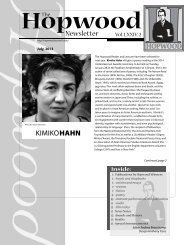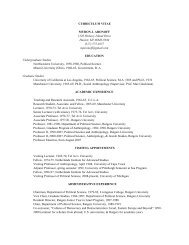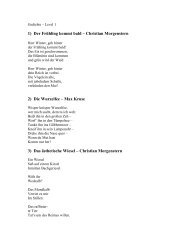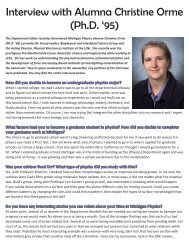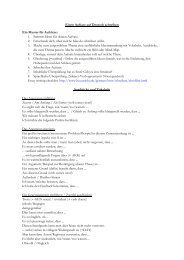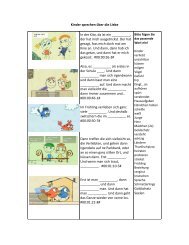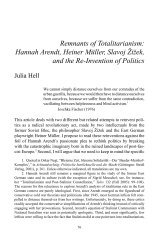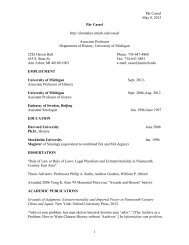Remember the Hand: Bodies and Bookmaking in Early Medieval ...
Remember the Hand: Bodies and Bookmaking in Early Medieval ...
Remember the Hand: Bodies and Bookmaking in Early Medieval ...
Create successful ePaper yourself
Turn your PDF publications into a flip-book with our unique Google optimized e-Paper software.
Downloaded by [ca<strong>the</strong>r<strong>in</strong>e brown] at 13:48 24 October 2011<br />
<strong>Remember</strong> <strong>the</strong> <strong>H<strong>and</strong></strong>: <strong>Bodies</strong> <strong>and</strong><br />
<strong>Bookmak<strong>in</strong>g</strong> <strong>in</strong> <strong>Early</strong> <strong>Medieval</strong><br />
Spa<strong>in</strong><br />
CATHERINE BROWN<br />
I admit that among those of your tasks which require physical effort that of <strong>the</strong><br />
scribe, if he writes correctly, appeals most to me. (Cassiodorus, Institutiones I.30.)<br />
Why should scribal work be so appeal<strong>in</strong>g to Cassiodorus? He surely does not<br />
mean that it is his favorite job <strong>in</strong> <strong>the</strong> monastery; it would be a mistake to<br />
imag<strong>in</strong>e <strong>the</strong> founder of Vivarium enjoy<strong>in</strong>g <strong>the</strong> manual labor of writ<strong>in</strong>g <strong>the</strong><br />
Institutiones <strong>in</strong> his own h<strong>and</strong>. Indeed, late ancient aristocrat that he was,<br />
Cassiodorus (d. 580 CE) almost certa<strong>in</strong>ly got no <strong>in</strong>k on his h<strong>and</strong>s when he<br />
dictated this praise of <strong>the</strong> scribe. The act of writ<strong>in</strong>g he has <strong>in</strong> m<strong>in</strong>d is entirely<br />
<strong>in</strong>strumental: it is a means to an end, <strong>and</strong> that end is <strong>the</strong> dissem<strong>in</strong>ation of ‘‘<strong>the</strong><br />
precepts of <strong>the</strong> Lord’’ [‘‘Dom<strong>in</strong>i praecepta’’].<br />
Happy his [<strong>the</strong> scribe’s] design, praiseworthy his zeal, to preach to men with <strong>the</strong><br />
h<strong>and</strong> alone, to unleash tongues with <strong>the</strong> f<strong>in</strong>gers, to give salvation silently to<br />
mortals, <strong>and</strong> to fight aga<strong>in</strong>st <strong>the</strong> illicit temptations of <strong>the</strong> devil with pen <strong>and</strong> <strong>in</strong>k.<br />
[felix <strong>in</strong>tentio, laud<strong>and</strong>a sedulitas, manu hom<strong>in</strong>ibus praedicare, digitis l<strong>in</strong>guas<br />
aperire, salutem mortalibus tacitum dare, et contra diaboli subreptiones illicitas<br />
calamo atramentoque pugnare.] 1<br />
Cassiodorus mentions <strong>the</strong>se fleshly h<strong>and</strong>s <strong>and</strong> <strong>the</strong>ir material <strong>in</strong>struments only to<br />
figure away <strong>the</strong>ir corporeal specificity: ‘‘Every word of <strong>the</strong> Lord written by <strong>the</strong> scribe<br />
is a wound <strong>in</strong>flicted on Satan’’ [‘‘Tot enim vulnera Satanas accipit quot antiquarius<br />
Dom<strong>in</strong>i verba describit’’], he concludes (Cassiodorus, Institutiones I.30.1).<br />
While Cassiodorus treats <strong>the</strong> nexus of corporeal <strong>in</strong>scription <strong>and</strong> spiritual<br />
efficacy from <strong>the</strong> position of an observer of writ<strong>in</strong>g, his younger contemporary<br />
Gregory <strong>the</strong> Great (d. 604) approaches it as an observer of read<strong>in</strong>g. He beg<strong>in</strong>s<br />
<strong>the</strong> preface of his massive commentary on <strong>the</strong> book of Job, <strong>the</strong> Moralia<br />
(f<strong>in</strong>ished 595), with a reader’s question: ‘‘It is often asked, ‘Who wrote <strong>the</strong><br />
book of Job?’’’ [‘Inter multos saepe quaeritur, quis libri beati iob scriptor<br />
habeatur’]. 2 For a paragraph <strong>and</strong> a half Gregory enterta<strong>in</strong>s various attributions<br />
of <strong>the</strong> biblical book, but <strong>the</strong>n dismisses <strong>the</strong>m: <strong>the</strong> author, not <strong>the</strong> writer,<br />
is <strong>the</strong> one who matters. ‘‘It would be foolish <strong>in</strong>deed to <strong>in</strong>quire who wrote <strong>the</strong><br />
book, when one faithfully believes that <strong>the</strong> Holy Spirit is <strong>the</strong> author’’ [‘‘Sed<br />
quis haec scripserit, ualde superuacue quaeritur, cum tamen auctor libri<br />
spiritus sanctus fideliter credatur’’]. 3<br />
In his ensu<strong>in</strong>g discussion, Gregory takes pa<strong>in</strong>s to establish <strong>the</strong> difference<br />
between authors <strong>and</strong> pen-pushers:<br />
The writer is <strong>the</strong> one who dictates th<strong>in</strong>gs to be written. The writer is <strong>the</strong> one who<br />
<strong>in</strong>spires <strong>the</strong> book <strong>and</strong> recounts through <strong>the</strong> voice of <strong>the</strong> scribe <strong>the</strong> deeds we are to<br />
imitate. We might read <strong>the</strong> words of some great man <strong>in</strong> his letters but ask by<br />
This essay has been enriched by <strong>the</strong> eyes <strong>and</strong><br />
ideas of audiences at Bryn Mawr College,<br />
Cornell University, <strong>and</strong> <strong>the</strong> <strong>Medieval</strong><br />
Academy of America, <strong>and</strong> by <strong>the</strong> many<br />
friends <strong>and</strong> colleagues who read drafts <strong>and</strong><br />
patiently offered suggestions. Special thanks<br />
to John Williams for his unfail<strong>in</strong>g generosity.<br />
1 – Cassiodorus, Institutiones I.30.1. Lat<strong>in</strong> from<br />
Cassiodorus, Cassiodori Senatoris Institutiones, ed.<br />
Roger Aubrey Baskerville Mynors (Oxford:<br />
Clarendon Press, 1937), p. 75. Translation:<br />
Cassiodorus, Div<strong>in</strong>e <strong>and</strong> Human Letters, trans.<br />
Leslie Webber Jones (New York: Columbia<br />
University Press, 1946), p. 133. Citations of<br />
primary texts will be by st<strong>and</strong>ard divisions,<br />
divided by periods (Book.chapter.paragraph),<br />
followed after a semicolon by page numbers<br />
<strong>in</strong> modern editions. Where no translator is<br />
credited, <strong>the</strong> version is my own.<br />
2 – Pope Gregory I, Moralia <strong>in</strong> Job, Praef.1, ed.<br />
Marcus Adriaen, Corpus Christianorum<br />
Series Lat<strong>in</strong>a (Turnholt: Brepols, 1979), vol.<br />
143, p. 8.<br />
3 – Ibid.<br />
262 WORD & IMAGE, VOL. 27, NO. 3, JULY–SEPTEMBER 2011<br />
Word & Image ISSN 0266-6286 # 2011 Taylor & Francis<br />
http://www.t<strong>and</strong>f.co.uk/journals/tf/02666286.html<br />
http://dx.doi.org/10.1080/02666286.2011.541112



